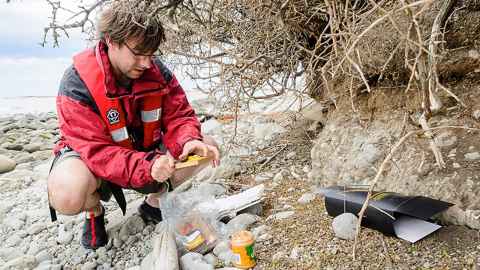Take 10 with... James Russell
Professor James Russell gives us 10 minutes of his time to discuss how he uses science to protect New Zealand's unique fauna by removing the threats posed by introduced mammals.

1. Describe your research topic to us in 10 words or less.
Conservation and restoration of New Zealand’s biodiversity.
2. Now describe it in everyday terms!
I use science to help maximise the protection of New Zealand’s unique species, such as birds, skinks and geckos, with a focus on removing their number one threat which is mammals introduced by humans such as rats, stoats and possums (and many more).
3. What are some of the day-to-day research activities you carry out?
I am most happy when on a remote island studying the biology of its introduced mammals to help plan their removal or surveying the recovery of species such as seabirds after introduced mammals have been eradicated. This can involve working through either the day or night depending on the behaviour of the species being studied. I’ll work hard collecting as much data as possible to analyse once I’m back in the office.
4. What do you enjoy most about your research?
The most enjoyable part of my work is seeing parts of New Zealand which are as close as possible to how New Zealand used to be, and the reward I get from restoring islands closer to this, and saving countless animal lives along the way. Its also great meeting everyday New Zealanders who share this passion for our native species and do their bit.
5. Tell us something that has surprised or amused you in the course of your research.
During my doctoral studies I was tracking rats on islands and lost one rat for 18 weeks before I found it again. Although a research disaster at the time, the rat eventually became world famous, published in Nature, on the front page of the New York Times and turned in to a children’s book by famed author Witi Ihimaera. While I was finishing writing my doctoral thesis I visited primary schools performing the book as a school play.
6. How have you approached any challenges you’ve faced in your research?
Everything that happens is an opportunity to be capitalised on and something to be learnt from. For example, when we fail to eradicate rats from an island the first time, its only really a failure if we don’t learn from it and succeed the second time.
7. What questions have emerged as a result?
Most of our questions now are around just how big can we go with island eradications, given it is one of the largest returns on investment for conservation dollars, and a relatively cheap one at that (the most expensive ones only being millions of dollars). A lot of my research today is on how we can ‘go to scale’ such as achieving a Predator Free New Zealand.
8. What kind of impact do you hope your research will have?
Ultimately, I hope to see New Zealand predator free (i.e. no more rats, stoats or possums) in my lifetime, but at least that New Zealand’s native biodiversity has an incredible resurgence back to its former glory.
9. If you collaborate across the faculty or University, or even outside the University, who do you work with and how does it benefit your research?
One of my favourite collaborators at the moment is Dr Emily Parke in Philosophy who helps me understand a lot of the questions I ask from a completely different perspective. Outside the University I work closely with the Department of Conservation who safeguard and provide access to the islands I work on, and have the capacity to enact the conservation policy and actions that emerge from my research.
10. What one piece of advice would you give your younger, less experienced research self?
It's a marathon, not a sprint. Plan decades rather than years ahead..you’ll get to the finish line eventually, so make sure you pace yourself.